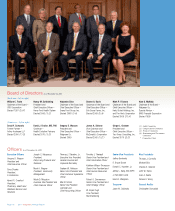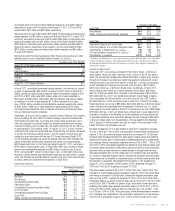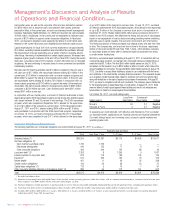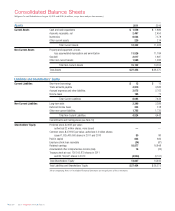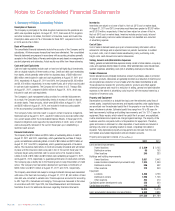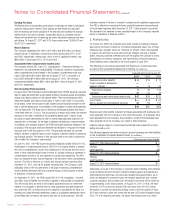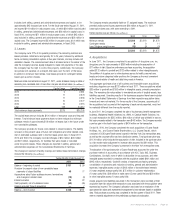Walgreens 2011 Annual Report Download - page 23
Download and view the complete annual report
Please find page 23 of the 2011 Walgreens annual report below. You can navigate through the pages in the report by either clicking on the pages listed below, or by using the keyword search tool below to find specific information within the annual report.
in the estimated discount rate. A 1% increase in estimated discount rates for the
two reporting units whose fair value exceeded carrying value by 10% or less would
also have resulted in the reporting units failing step one. The Company believes
that its estimates of future cash flows and discount rates are reasonable, but
future changes in the underlying assumptions could differ due to the inherent
uncertainty in making such estimates.
We have not made any material changes to the method of evaluating goodwill
and intangible asset impairments during the last three years. Based on current
knowledge, we do not believe there is a reasonable likelihood that there will be a
material change in the estimates or assumptions used to determine impairment.
Allowance for doubtful accounts – The provision for bad debt is based on both
specific receivables and historic write-off percentages. We have not made any
material changes to the method of estimating our allowance for doubtful accounts
during the last three years. Based on current knowledge, we do not believe there
is a reasonable likelihood that there will be a material change in the estimates
or assumptions used to determine the allowance.
Vendor allowances – Vendor allowances are principally received as a result of
purchases, sales or promotion of vendors’ products. Allowances are generally
recorded as a reduction of inventory and are recognized as a reduction of cost
of sales when the related merchandise is sold. Those allowances received for
promoting vendors’ products are offset against advertising expense and result
in a reduction of selling, general and administrative expenses to the extent of
advertising incurred, with the excess treated as a reduction of inventory costs.
We have not made any material changes to the method of estimating our vendor
allowances during the last three years. Based on current knowledge, we do not
believe there is a reasonable likelihood that there will be a material change in
the estimates or assumptions used to determine vendor allowances.
Asset impairments – The impairment of long-lived assets is assessed based upon
both qualitative and quantitative factors, including years of operation and expected
future cash flows, and tested for impairment annually or whenever events or
circumstances indicate that a certain asset may be impaired. If the future cash
flows reveal that the carrying value of the asset group may not be recoverable,
an impairment charge is immediately recorded. We have not made any material
changes to the method of estimating our asset impairments during the last three
years. Based on current knowledge, we do not believe there is a reasonable
likelihood that there will be a material change in the estimates or assumptions
used to determine asset impairments.
Liability for closed locations – The liability is based on the present value of future
rent obligations and other related costs (net of estimated sublease rent) to the first
lease option date. We have not made any material changes to the method of estimating
our liability for closed locations during the last three years. Based on current knowledge,
we do not believe there is a reasonable likelihood that there will be a material change
in the estimates or assumptions used to determine the liability.
Liability for insurance claims – The liability for insurance claims is recorded based
on estimates for claims incurred and is not discounted. The provisions are estimated
in part by considering historical claims experience, demographic factors and other
actuarial assumptions. We have not made any material changes to the method of
estimating our liability for insurance claims during the last three years. Based on current
knowledge, we do not believe there is a reasonable likelihood that there will be a
material change in the estimates or assumptions used to determine the liability.
Cost of sales – Drugstore cost of sales is derived based on point-of-sale scanning
information with an estimate for shrinkage and adjusted based on periodic inventory
counts. Inventories are valued at the lower of cost or market determined by the
last-in, first-out (LIFO) method. We have not made any material changes to the
method of estimating cost of sales during the last three years. Based on current
knowledge, we do not believe there is a reasonable likelihood that there will be a
material change in the estimates or assumptions used to determine cost of sales.
Income taxes – We are subject to routine income tax audits that occur periodically
in the normal course of business. U.S. federal, state and local and foreign tax
authorities raise questions regarding our tax filing positions, including the timing
and amount of deductions and the allocation of income among various tax jurisdic-
tions. In evaluating the tax benefits associated with our various tax filing positions,
we record a tax benefit for uncertain tax positions using the highest cumulative tax
benefit that is more likely than not to be realized. Adjustments are made to our
liability for unrecognized tax benefits in the period in which we determine the issue
is effectively settled with the tax authorities, the statute of limitations expires for
the return containing the tax position or when more information becomes available.
Our liability for unrecognized tax benefits, including accrued penalties and interest,
is included in other long-term liabilities on our consolidated balance sheets and in
income tax expense in our consolidated statements of earnings.
In determining our provision for income taxes, we use an annual effective income
tax rate based on full-year income, permanent differences between book and tax
income, and statutory income tax rates. The effective income tax rate also reflects
our assessment of the ultimate outcome of tax audits. Discrete events such as
audit settlements or changes in tax laws are recognized in the period in which
they occur. Based on current knowledge, we do not believe there is a reasonable
likelihood that there will be a material change in the estimates or assumptions
used to determine the amounts recorded for income taxes.
Liquidity and Capital Resources
Cash and cash equivalents were $1.6 billion at August 31, 2011, compared to
$1.9 billion at August 31, 2010. Short-term investment objectives are to minimize
risk, maintain liquidity and maximize after-tax yields. To attain these objectives,
investment limits are placed on the amount, type and issuer of securities. Investments
are principally in money market funds, U.S. Treasury market funds and Treasury Bills.
On October 14, 2009, our Board of Directors approved a long-term capital policy: to
maintain a strong balance sheet and financial flexibility; reinvest in our core strategies;
invest in strategic opportunities that reinforce our core strategies and meet return
requirements; and return surplus cash flow to shareholders in the form of dividends
and share repurchases over the long term.
Net cash provided by operating activities was $3.6 billion at August 31, 2011, compared
to $3.7 billion a year ago. The decrease from the prior year is primarily attributable to
higher working capital. For the year, working capital was a cash flow use of $155 million
as compared to the prior year where working capital improvements generated a cash
flow of $306 million. Partially offsetting the cash flow decrease in working capital
were higher earnings which positively contributed to cash from operations. Cash
provided by operations is the principal source of funds for expansion, acquisitions,
remodeling programs, dividends to shareholders and stock repurchases.
Net cash used for investing activities was $1.5 billion versus $1.3 billion last year.
Additions to property and equipment were $1.2 billion compared to $1.0 billion last
year. In fiscal 2011, we added a total of 297 locations (164 net) compared to last
year’s 670 locations (550 net), which included the acquisition of 258 Duane Reade
locations. There were 62 owned locations added during the year and 44 under
construction at August 31, 2011, versus 95 owned locations added and 65 under
construction as of August 31, 2010.
Infusion and
Work- Respiratory Specialty Mail
Drugstores sites Services Pharmacy Service Total
August 31, 2009 6,997 377 105 15 2 7,496
New/Relocated 359 24 4 1 — 388
Acquired 281 — 1 — — 282
Closed/Replaced (75) (34) (9) (2) — (120)
August 31, 2010 7,562 367 101 14 2 8,046
New/Relocated 237 21 1 2 — 261
Acquired 32 — 4 — — 36
Closed/Replaced (70) (33) (23) (7) — (133)
August 31, 2011 7,761 355 83 9 2 8,210
Business acquisitions this year were $630 million versus $779 million in fiscal 2010.
Business acquisitions in the current year included the purchase of drugstore.com, inc.,
for $398 million net of assumed cash, $29 million of infusion and respiratory services
assets and selected other assets (primarily prescription files). Business acquisitions in
2010 included the purchase of all 258 Duane Reade stores located in the New York City
2011 Walgreens Annual Report Page 21







